That’s it, the dialogue of the deaf on immigration begins again.
Each on their planet, Ottawa and Quebec cling to their plan, without taking the time to lead a healthy debate based on complete and conclusive data.
Granted, federal Immigration Minister Sean Fraser this week disassociated himself from the Initiative of the Century, a business plan to grow Canada’s population to 100 million by 2100.

PHOTO SEAN KILPATRICK, THE CANADIAN PRESS ARCHIVES
Sean Fraser, Minister of Immigration, Refugees and Citizenship of Canada
But in fact, the Liberal government is already moving in this direction… and even faster.
In 2022, Canada saw a record population increase of more than 1 million people, including 437,000 permanent immigrants and, for the first time, even more temporary ones (608,000).
This 2.7% increase ranks Canada first among OECD countries. At this rate, the population will have doubled in about 26 years, estimates Statistics Canada1. We will therefore be 80 million in Canada in 2050.
It is far from trivial.
But without fanfare, Canada has just raised its permanent immigration targets to 500,000 in 2025. All of this, without this crucial decision for the future of the country being the subject of a debate worthy of the name. All this, without the government explaining how these newcomers will be integrated.
Already, property builders are unable to keep up with the rising population. The current rental housing deficit will quadruple by 2026 if nothing changes, according to economists at the Royal Bank of Canada. So imagine the price of rents in 2050!
Sorry, immigration is not a tap that we open without asking questions, just because we want the Canada of tomorrow to weigh more heavily on the international scene.
You need a plan. A realistic plan.
Federal immigration targets place Quebec in a delicate situation. If the province wants to maintain its weight within the country, it must accept some 100,000 immigrants a year, which is not easy if we want to maintain the distinctive character of Quebec.
Premier François Legault has already declared that it would be “suicidal” to exceed the threshold of 50,000 immigrants per year. But what is this number based on? No one knows.
In Quebec as in Ottawa, you need a plan. A real.
Quebec Immigration Minister Christine Fréchette will soon hold consultations to establish permanent immigration targets for the next three years. Too bad she didn’t take the opportunity to organize a real states general on immigration which would have made it possible to broaden the debate, to take into account temporary residents whose explosion from zero in 2015 to 62,000 in 2019 has created a true two-tier system.

PHOTO JACQUES BOISSINOT, CANADIAN PRESS ARCHIVES
Christine Fréchette, Minister of Immigration, Francisation and Integration of Quebec
It suits the universities, who thus fill their classrooms with foreign students, and the employers who no longer know where to find labour.
But, to use Liberal MP Monsef Derraji’s image, what’s the point of limiting the number of permanent immigrants we welcome through the front door if temporary immigrants can enter through the garage door, which is wide open ?
Instead of tearing its shirt open by demanding more powers from Ottawa, which risks leading to a fruitless dispute, Quebec should use the levers it already has at its fingertips.
He could start by spending all of the generous envelope that Ottawa gives him for francization under the Canada-Quebec agreement on the sharing of powers in immigration.
There will always be a need for francization, because, let’s face it, aiming for 100% Francophone economic immigration, as mentioned by the CAQ, is not realistic. This would hamper the growth of certain key economic sectors, such as aerospace or the battery industry.
Then, Quebec should better oil its bureaucratic machine. Because of its administrative negligence, the province is being beaten by the federal government, which has finally decided to reach its target of 4.4% Francophone immigration outside Quebec, which we can only rejoice in.
But this means that French-speaking immigrants prefer to settle outside Quebec, because it is less long, less complicated and less expensive, as reported by our colleague Suzanne Colpron.2.
Finally, why not bet a little more on the promotion of the language, rather than on coercion and guilt? We won’t get anywhere by blaming the decline of French on young people, as in the peregrine falcon advertisement.
Why not focus on the positive?
For example, did you know that workers who speak both languages in Quebec have a median income ($39,909) that is 24 to 36% higher than that of workers who speak only French ($32,294) or English ($29,248), according to the Office québécois de la langue française 3 ?
How bilingualism pays off! And learning French for immigrants pays off, in every sense of the word!
